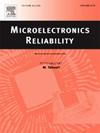等温时效和热循环对Sn-1.0Ag-0.5Cu焊点界面和剪切性能的增强
IF 1.9
4区 工程技术
Q3 ENGINEERING, ELECTRICAL & ELECTRONIC
引用次数: 0
摘要
研究了Sn-1.0Ag-0.5Cu钎料中添加微量Ge对其等温时效和热循环过程中界面和剪切性能的影响。回流焊后,微量Ge优先溶解在β-Sn基体中,使界面由锯齿形变为扇形,减少了界面化合物(IMCs)的厚度,提高了焊点的剪切强度。时效过程中,Ge降低了Sn原子的扩散,减少了界面处Cu6Sn5和Cu3Sn的生成,提高了接头的抗高温剪切强度。在热循环试验中,Ge的加入显著降低了接头内部的热应力,阻止了断口从焊料向界面的扩展,提高了接头的热循环可靠性。通过对失效模式的比较,热循环过程中IMC的生长速度要慢于时效过程,微量Ge的加入对热循环过程中IMC层的生长有更好的抑制作用。本文章由计算机程序翻译,如有差异,请以英文原文为准。
Enhancement on interface and shear properties of Sn-1.0Ag-0.5Cu solder joints by 0.05 % Ge under isothermal aging and thermal cycling
This study evaluated the influence of trace Ge addition into Sn-1.0Ag-0.5Cu solder on the interface and shear properties during isothermal aging and thermal cycling. After reflow soldering, trace Ge preferentially dissolved in the β-Sn matrix, modified the interfacial geometry from serrated to scallop with reduced thickness of the interfacial compounds (IMCs), and increased the shear strength on solder joints. During aging, Ge reduced the diffusion of Sn atoms and the production of Cu6Sn5 and Cu3Sn at the interface, and enhanced the high temperature-resistance on the shear strength of the joints. In thermal cycling tests, Ge addition considerably reduced the thermal stress within the joints, prevented the propagation of fractures from the solder to the interface, and increased the thermal cycling reliability of the joints. By comparing the failure modes, the IMC growth during thermal cycling was slower than that during aging, and the trace Ge addition had a better inhibitory effect on the growth of IMC layer during thermal cycling.
求助全文
通过发布文献求助,成功后即可免费获取论文全文。
去求助
来源期刊

Microelectronics Reliability
工程技术-工程:电子与电气
CiteScore
3.30
自引率
12.50%
发文量
342
审稿时长
68 days
期刊介绍:
Microelectronics Reliability, is dedicated to disseminating the latest research results and related information on the reliability of microelectronic devices, circuits and systems, from materials, process and manufacturing, to design, testing and operation. The coverage of the journal includes the following topics: measurement, understanding and analysis; evaluation and prediction; modelling and simulation; methodologies and mitigation. Papers which combine reliability with other important areas of microelectronics engineering, such as design, fabrication, integration, testing, and field operation will also be welcome, and practical papers reporting case studies in the field and specific application domains are particularly encouraged.
Most accepted papers will be published as Research Papers, describing significant advances and completed work. Papers reviewing important developing topics of general interest may be accepted for publication as Review Papers. Urgent communications of a more preliminary nature and short reports on completed practical work of current interest may be considered for publication as Research Notes. All contributions are subject to peer review by leading experts in the field.
 求助内容:
求助内容: 应助结果提醒方式:
应助结果提醒方式:


